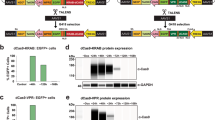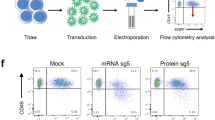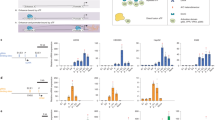Abstract
Achieving transgene integration into preselected genomic sites is currently one of the central tasks in stem cell gene therapy. A strategy to mediate such targeted integration involves site-specific endonucleases. Two genomic sites within the MBS85 and chemokine (C-C motif) receptor 5 (CCR5) genes (AAVS1 and CCR5 zinc-finger nuclease (CCR5-ZFN) sites, respectively) have recently been suggested as potential target regions for integration as their disruption has no functional consequence. We hypothesized that efficient transgene integration maybe affected by DNA accessibility of endonucleases and therefore studied the transcriptional and chromatin status of the AAVS1 and CCR5 sites in eight human induced pluripotent stem (iPS) cell lines and pooled CD34+ hematopoietic stem cells (HSCs). Matrix chromatin immunoprecipitation (ChIP) assays demonstrated that the CCR5 site and surrounding regions possessed a predominantly closed chromatin configuration consistent with its transcriptional inactivity in these cell types. In contrast, the AAVS1 site was located within a transcriptionally active region and exhibited an open chromatin configuration in both iPS cells and HSCs. To show that the AAVS1 site is readily amendable to genome modification, we expressed Rep78, an AAV2-derived protein with AAVS1-specific endonuclease activity, in iPS cells after adenoviral gene transfer. We showed that Rep78 efficiently associated with the AAVS1 site and triggered genome modifications within this site. On the other hand, binding to and modification of the CCR5-ZFN site by a ZFN was relatively inefficient. Our data suggest a critical influence of chromatin structure on efficacy of site-specific endonucleases used for genome editing.
This is a preview of subscription content, access via your institution
Access options
Subscribe to this journal
Receive 12 print issues and online access
$259.00 per year
only $21.58 per issue
Buy this article
- Purchase on Springer Link
- Instant access to full article PDF
Prices may be subject to local taxes which are calculated during checkout









Similar content being viewed by others
References
Voigt K, Izsvak Z, Ivics Z . Targeted gene insertion for molecular medicine. J Mol Med 2008; 86: 1205–1219.
Kramer O, Klausing S, Noll T . Methods in mammalian cell line engineering: from random mutagenesis to sequence-specific approaches. Appl Microbiol Biotechnol 2010; 88: 425–436.
Miller DG, Petek LM, Russell DW . Adeno-associated virus vectors integrate at chromosome breakage sites. Nat Genet 2004; 36: 767–773.
Li H, Haurigot V, Doyon Y, Li T, Wong SY, Bhagwat AS et al. In vivo genome editing restores haemostasis in a mouse model of haemophilia. Nature 2011; 475: 217–221.
Lombardo A, Genovese P, Beausejour CM, Colleoni S, Lee YL, Kim KA et al. Gene editing in human stem cells using zinc-finger nucleases and integrase-defective lentiviral vector delivery. Nat Biotechnol 2007; 25: 1298–1306.
Wang H, Lieber A . A helper-dependent capsid-modified adenovirus vector expressing adeno-associated virus rep78 mediates site-specific integration of a 27-kilobase transgene cassette. J Virol 2006; 80: 11699–11709.
Wang H, Shayakhmetov DM, Leege T, Harkey M, Li Q, Papayannopoulou T et al. A capsid-modified helper-dependent adenovirus vector containing the beta-globin locus control region displays a nonrandom integration pattern and allows stable, erythroid-specific gene expression. J Virol 2005; 79: 10999–11013.
Recchia A, Perani L, Sartori D, Olgiati C, Mavilio F . Site-specific integration of functional transgenes into the human genome by adeno/AAV hybrid vectors. Mol Ther 2004; 10: 660–670.
Suzuki K, Mitsui K, Aizawa E, Hasegawa K, Kawase E, Yamagishi T et al. Highly efficient transient gene expression and gene targeting in primate embryonic stem cells with helper-dependent adenoviral vectors. Proc Natl Acad Sci USA 2008; 105: 13781–13786.
Holt N, Wang J, Kim K, Friedman G, Wang X, Taupin V et al. Human hematopoietic stem/progenitor cells modified by zinc-finger nucleases targeted to CCR5 control HIV-1 in vivo. Nat Biotechnol 2010; 28: 839–847.
Hockemeyer D, Wang H, Kiani S, Lai CS, Gao Q, Cassady JP et al. Genetic engineering of human pluripotent cells using TALE nucleases. Nat Biotechnol 2011; 29: 731–734.
Liu R, Paxton WA, Choe S, Ceradini D, Martin SR, Horuk R et al. Homozygous defect in HIV-1 coreceptor accounts for resistance of some multiply-exposed individuals to HIV-1 infection. Cell 1996; 86: 367–377.
Hutter G, Nowak D, Mossner M, Ganepola S, Mussig A, Allers K et al. Long-term control of HIV by CCR5 Delta32/Delta32 stem-cell transplantation. N Engl J Med 2009; 360: 692–698.
Perez EE, Wang J, Miller JC, Jouvenot Y, Kim KA, Liu O et al. Establishment of HIV-1 resistance in CD4+ T cells by genome editing using zinc-finger nucleases. Nat Biotechnol 2008; 26: 808–816.
Benabdallah BF, Allard E, Yao S, Friedman G, Gregory PD, Eliopoulos N et al. Targeted gene addition to human mesenchymal stromal cells as a cell-based plasma-soluble protein delivery platform. Cytotherapy 2010; 12: 394–399.
Kandavelou K, Ramalingam S, London V, Mani M, Wu J, Alexeev V et al. Targeted manipulation of mammalian genomes using designed zinc finger nucleases. Biochem Biophys Res Commun 2009; 388: 56–61.
Kim HJ, Lee HJ, Kim H, Cho SW, Kim JS . Targeted genome editing in human cells with zinc finger nucleases constructed via modular assembly. Genome Res 2009; 19: 1279–1288.
Kotin RM, Linden RM, Berns KI . Characterization of a preferred site on human chromosome 19q for integration of adeno-associated virus DNA by non-homologous recombination. EMBO J 1992; 11: 5071–5078.
Smith JR, Maguire S, Davis LA, Alexander M, Yang F, Chandran S et al. Robust, persistent transgene expression in human embryonic stem cells is achieved with AAVS1-targeted integration. Stem Cells 2008; 26: 496–504.
Hockemeyer D, Soldner F, Beard C, Gao Q, Mitalipova M, DeKelver RC et al. Efficient targeting of expressed and silent genes in human ESCs and iPSCs using zinc-finger nucleases. Nat Biotechnol 2009; 27: 851–857.
Henckaerts E, Dutheil N, Zeltner N, Kattman S, Kohlbrenner E, Ward P et al. Site-specific integration of adeno-associated virus involves partial duplication of the target locus. Proc Natl Acad Sci USA 2009; 106: 7571–7576.
Meneses P, Berns KI, Winocour E . DNA sequence motifs which direct adeno-associated virus site-specific integration in a model system. J Virol 2000; 74: 6213–6216.
Cortes ML, Oehmig A, Saydam O, Sanford JD, Perry KF, Fraefel C et al. Targeted integration of functional human ATM cDNA into genome mediated by HSV/AAV hybrid amplicon vector. Mol Ther 2008; 16: 81–88.
Howden SE, Voullaire L, Wardan H, Williamson R, Vadolas J . Site-specific, Rep-mediated integration of the intact beta-globin locus in the human erythroleukaemic cell line K562. Gene Therapy 2008; 15: 1372–1383.
Efroni S, Duttagupta R, Cheng J, Dehghani H, Hoeppner DJ, Dash C et al. Global transcription in pluripotent embryonic stem cells. Cell Stem Cell 2008; 2: 437–447.
Meshorer E, Yellajoshula D, George E, Scambler PJ, Brown DT, Misteli T . Hyperdynamic plasticity of chromatin proteins in pluripotent embryonic stem cells. Dev Cell 2006; 10: 105–116.
Carter MG, Sharov AA, VanBuren V, Dudekula DB, Carmack CE, Nelson C et al. Transcript copy number estimation using a mouse whole-genome oligonucleotide microarray. Genome Biol 2005; 6: R61.
Gaspar-Maia A, Alajem A, Polesso F, Sridharan R, Mason MJ, Heidersbach A et al. Chd1 regulates open chromatin and pluripotency of embryonic stem cells. Nature 2009; 460: 863–868.
Wang GP, Ciuffi A, Leipzig J, Berry CC, Bushman FD . HIV integration site selection: analysis by massively parallel pyrosequencing reveals association with epigenetic modifications. Genome Res 2007; 17: 1186–1194.
Huser D, Gogol-Doring A, Lutter T, Weger S, Winter K, Hammer EM et al. Integration preferences of wildtype AAV-2 for consensus rep-binding sites at numerous loci in the human genome. PLoS Pathog 2010; 6: e1000985.
Djuric U, Ellis J . Epigenetics of induced pluripotency, the seven-headed dragon. Stem Cell Res Ther 2010; 1: 3.
Chamberlain JR, Deyle DR, Schwarze U, Wang P, Hirata RK, Li Y et al. Gene targeting of mutant COL1A2 alleles in mesenchymal stem cells from individuals with osteogenesis imperfecta. Mol Ther 2008; 16: 187–193.
Deyle DR, Khan IF, Raen G, Wang P, Kho J, Schwarze U et al. Normal collagen and bone production by gene-targeted human osteogenesis imperfecta iPSCs. Mol Ther 2011; 20: 204–213.
Snider L, Geng LN, Lemmers RJ, Kyba M, Ware CB, Nelson AM et al. Facioscapulohumeral dystrophy: incomplete suppression of a retrotransposed gene. PLoS Genet 2010; 6: e1001181.
Stadler B, Ivanovska I, Mehta K, Song S, Nelson A, Tan Y et al. Characterization of microRNAs involved in embryonic stem cell states. Stem Cells Dev 2010; 19: 935–950.
Chang KH, Huang A, Hirata RK, Wang PR, Russell DW, Papayannopoulou T . Globin phenotype of erythroid cells derived from human induced pluripotent stem cells. Blood 2010; 115: 2553–2554.
Chan EM, Ratanasirintrawoot S, Park IH, Manos PD, Loh YH, Huo H et al. Live cell imaging distinguishes bona fide human iPS cells from partially reprogrammed cells. Nat Biotechnol 2009; 27: 1033–1037.
Lieberman PM . Chromatin regulation of virus infection. Trends Microbiol 2006; 14: 132–140.
Flanagin S, Nelson JD, Castner DG, Denisenko O, Bomsztyk K . Microplate-based chromatin immunoprecipitation method, Matrix ChIP: a platform to study signaling of complex genomic events. Nucleic Acids Res 2008; 36: e17.
Nelson JD, Denisenko O, Bomsztyk K . Protocol for the fast chromatin immunoprecipitation (ChIP) method. Nat Protoc 2006; 1: 179–185.
Taylor JA, Vojtech L, Bahner I, Kohn DB, Laer DV, Russell DW et al. Foamy virus vectors expressing anti-HIV transgenes efficiently block HIV-1 replication. Mol Ther 2008; 16: 46–51.
Dutheil N, Henckaerts E, Kohlbrenner E, Linden RM . Transcriptional analysis of the adeno-associated virus integration site. J Virol 2009; 83: 12512–12525.
Tuve S, Wang H, Ware C, Liu Y, Gaggar A, Bernt K et al. A new group B adenovirus receptor is expressed at high levels on human stem and tumor cells. J Virol 2006; 80: 12109–12120.
Shayakhmetov DM, Papayannopoulou T, Stamatoyannopoulos G, Lieber A . Efficient gene transfer into human CD34(+) cells by a retargeted adenovirus vector. J Virol 2000; 74: 2567–2583.
Tashiro K, Kawabata K, Inamura M, Takayama K, Furukawa N, Sakurai F et al. Adenovirus vector-mediated efficient transduction into human embryonic and induced pluripotent stem cells. Cell Reprogram 2010; 12: 501–507.
Rufaihah AJ, Huang NF, Jame S, Lee J, Nguyen HN, Byers B et al. Endothelial cells derived from human iPSCS increase capillary density and improve perfusion in a mouse model of peripheral arterial disease. Arterioscler Thromb Vasc Biol 2011; 31: e72–e79.
Samavarchi-Tehrani P, Golipour A, David L, Sung H-k, Beyer TA, Datti A et al. Functional genomics reveals a BMP-driven mesenchymal-to-epithelial transition in the initiation of somatic cell reprogramming. Cell Stem Cell 2010; 7: 64–77.
Wang H, Li ZY, Liu Y, Persson J, Beyer I, Moller T et al. Desmoglein 2 is a receptor for adenovirus serotypes 3, 7, 11 and 14. Nat Med 2011; 17: 96–104.
Ohgushi M, Matsumura M, Eiraku M, Murakami K, Aramaki T, Nishiyama A et al. Molecular pathway and cell state responsible for dissociation-induced apoptosis in human pluripotent stem cells. Cell Stem Cell 2010; 7: 225–239.
Casto BC, Armstrong JA, Atchison RW, Hammon WM . Studies on the relationship between adeno-associated virus type 1 (AAV-1) and adenoviruses. II. Inhibition of adenovirus plaques by AAV; its nature and specificity. Virology 1967; 33: 452–458.
Moosmann P, Georgiev O, Thiesen HJ, Hagmann M, Schaffner W . Silencing of RNA polymerases II and III-dependent transcription by the KRAB protein domain of KOX1, a Kruppel-type zinc finger factor. Biol Chem 1997; 378: 669–677.
Szulc J, Wiznerowicz M, Sauvain MO, Trono D, Aebischer P . A versatile tool for conditional gene expression and knockdown. Nat Methods 2006; 3: 109–116.
Drew HR, Lockett LJ, Both GW . Increased complexity of wild-type adeno-associated virus-chromosomal junctions as determined by analysis of unselected cellular genomes. J Gen Virol 2007; 88 (Part 6): 1722–1732.
Miller JC, Holmes MC, Wang J, Guschin DY, Lee YL, Rupniewski I et al. An improved zinc-finger nuclease architecture for highly specific genome editing. Nat Biotechnol 2007; 25: 778–785.
Shimizu K, Sakurai F, Machitani M, Katayama K, Mizuguchi H . Quantitative analysis of the leaky expression of adenovirus genes in cells transduced with a replication-incompetent adenovirus vector. Mol Pharm 2011; 8: 1430–1435.
John S, Sabo PJ, Thurman RE, Sung MH, Biddie SC, Johnson TA et al. Chromatin accessibility pre-determines glucocorticoid receptor binding patterns. Nat Genet 2011; 43: 264–268.
Hawkins RD, Hon GC, Lee LK, Ngo Q, Lister R, Pelizzola M et al. Distinct epigenomic landscapes of pluripotent and lineage-committed human cells. Cell Stem Cell 2010; 6: 479–491.
Stadtfeld M, Hochedlinger K . Induced pluripotency: history, mechanisms, and applications. Genes Dev 2010; 24: 2239–2263.
Kolasinska-Zwierz P, Down T, Latorre I, Liu T, Liu XS, Ahringer J . Differential chromatin marking of introns and expressed exons by H3K36me3. Nat Genet 2009; 41: 376–381.
Barrand S, Andersen IS, Collas P . Promoter-exon relationship of H3 lysine 9, 27, 36 and 79 methylation on pluripotency-associated genes. Biochem Biophys Res Commun 2010; 401: 611–617.
Lombardo A, Cesana D, Genovese P, Di Stefano B, Provasi E, Colombo DF et al. Site-specific integration and tailoring of cassette design for sustainable gene transfer. Nat Methods 2011; 8: 861–869.
Lieber A, He CY, Kirillova I, Kay MA . Recombinant adenoviruses with large deletions generated by Cre-mediated excision exhibit different biological properties compared with first-generation vectors in vitro and in vivo. J Virol 1996; 70: 8944–8960.
Avanzi GC, Lista P, Giovinazzo B, Miniero R, Saglio G, Benetton G et al. Selective growth response to IL-3 of a human leukaemic cell line with megakaryoblastic features. Br J Haematol 1988; 69: 359–366.
Yoon-Robarts M, Linden RM . Identification of active site residues of the adeno-associated virus type 2 Rep endonuclease. J Biol Chem 2003; 278: 4912–4918.
Trempe JP, Mendelson E, Carter BJ . Characterization of adeno-associated virus rep proteins in human cells by antibodies raised against rep expressed in Escherichia coli. Virology 1987; 161: 18–28.
Shayakhmetov DM, Lieber A . Dependence of adenovirus infectivity on length of the fiber shaft domain. J Virol 2000; 74: 10274–10286.
Wang H, Shayakhmetov DM, Leege T, Harkey M, Li Q, Papayannopoulou T et al. A capsid-modified helper-dependent adenovirus vector containing the {beta}-globin locus control region displays a nonrandom integration pattern and allows stable, erythroid-specific gene expression. J Virol 2005; 79: 10999–11013.
Samulski RJ, Zhu X, Xiao X, Brook JD, Housman DE, Epstein N et al. Targeted integration of adeno-associated virus (AAV) into human chromosome 19 [published erratum appears in EMBO J 1992 Mar;11(3):1228]. EMBO J 1991; 10: 3941–3950.
Khan IF, Hirata RK, Wang PR, Li Y, Kho J, Nelson A et al. Engineering of human pluripotent stem cells by AAV-mediated gene targeting. Mol Ther 2010; 18: 1192–1199.
Acknowledgements
This study was supported by NIH grants R21HL094994 (AL), R01 HLA078836 (AL), R01CA136487 (AL), R01CA141018 (KB), R01DK083310 (KB), R37DK45978 (KB) and NIH/NIDDK DK grant R37-45978. We thank Drs. Linden and Trempe for providing Rep78 antibodies. We are grateful to Carol Ware and the members of the Ellison Stem Cell Core Laboratory of the Institute of Stem Cell and Regenerative Medicine.
Author information
Authors and Affiliations
Corresponding author
Ethics declarations
Competing interests
The authors declare no conflict of interest.
Rights and permissions
About this article
Cite this article
van Rensburg, R., Beyer, I., Yao, XY. et al. Chromatin structure of two genomic sites for targeted transgene integration in induced pluripotent stem cells and hematopoietic stem cells. Gene Ther 20, 201–214 (2013). https://doi.org/10.1038/gt.2012.25
Received:
Revised:
Accepted:
Published:
Issue Date:
DOI: https://doi.org/10.1038/gt.2012.25
Keywords
This article is cited by
-
Establishment and characterization of a novel human induced pluripotent stem cell line stably expressing the iRFP720 reporter
Scientific Reports (2022)
-
Validation of reliable safe harbor locus for efficient porcine transgenesis
Functional & Integrative Genomics (2022)
-
TALEN mediated gene editing in a mouse model of Fanconi anemia
Scientific Reports (2020)
-
CRISPR/Cas9-based genetic correction for recessive dystrophic epidermolysis bullosa
npj Regenerative Medicine (2016)
-
Excision of Expanded GAA Repeats Alleviates the Molecular Phenotype of Friedreich's Ataxia
Molecular Therapy (2015)



